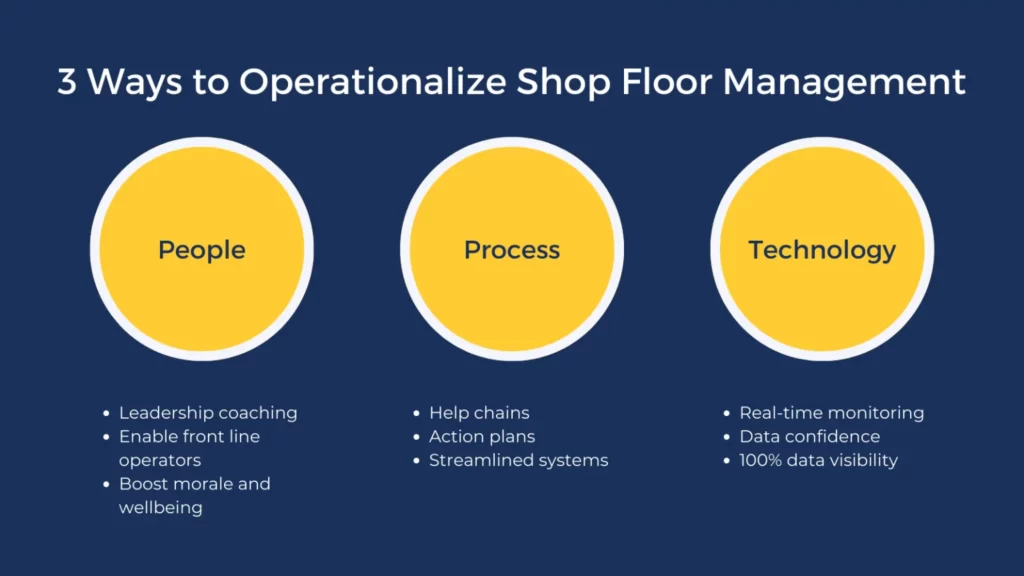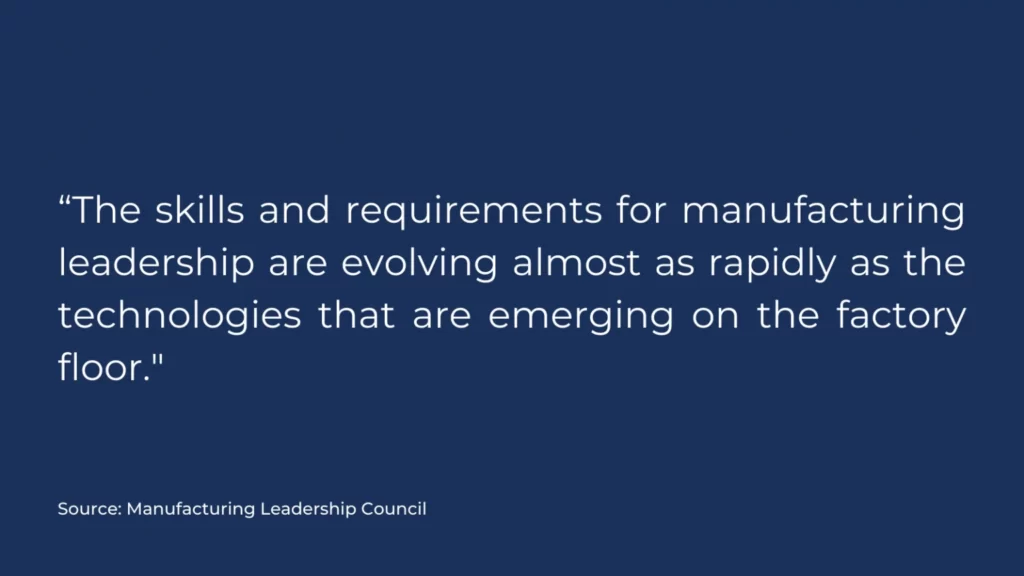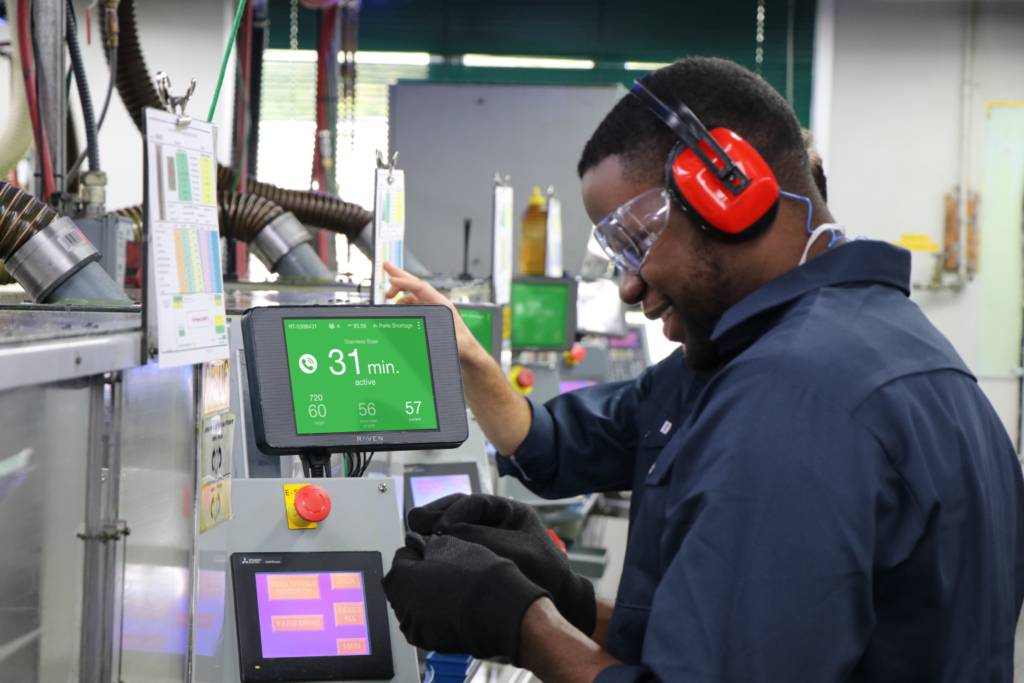The role of a leader in shop floor management has become much more difficult over the last few years as a result of the brain-drain — also known as The Great Resignation. Most of the technical support staff has retired, employee turnover is high, and many manufacturers have new workers with limited manufacturing experience to date.
On top of this, orders are late due to supply chain problems and workforce shortages. When problems arise, the responsibility to manage these issues falls on management.
These immediate issues and other systemic issues can be resolved by empowering frontline operations and shop floor management to establish effective continuous improvement initiatives.
So, what can be done to help shop floor leaders be more effective?
In this blog, we look at three primary areas where an organization can make improvements for overall success on the shop floor and a higher ROI:
- People – Engage an executive coach
- Processes – Implement help chains and action plans
- Technology – Employ real-time monitoring
What is shop floor management?
Shop floor management is a concept applied to the management of a production floor with a focus on people and business success by establishing and executing efficient, sustainable and quality processes. One way to operationalize shop floor management is to organize the floor by people, process and technology.

The importance of leadership on the shop floor
Effective leadership is central to the success of a factory floor. A manufacturer with happy workers can roll out lean processes and deploy technologies for continuous improvement in a more collaborative environment.
When shop floor leadership is enabled to take smarter actions that resolve root causes of issues and in turn reduce downtime, they will positively impact people and business by reaching goals that drive capacity, labor costs savings and ROI.
However, any role that involves shop floor management requires a specific skill set paired with a commitment from the organization to provide ongoing coaching or development.
How leadership can benefit by engaging an executive coach
The expectation to lead better and inspire followership is ever increasing. “The skills and requirements for manufacturing leadership are evolving almost as rapidly as the technologies that are emerging on the factory floor”, noted The Manufacturing Leadership Council.
Manufacturing organizations should consider engaging an executive coach to work with shop floor management to help them improve their leadership skills. Investing in a coach demonstrates to the shop floor leader the value that is placed in them. The investment also demonstrates to the workforce how much the organization values them. The payback? Lower turnover, a workforce with higher engagement levels, and a more equipped leadership team.

The importance of implementing help-chain and reaction plans
A problem without a solution or clear path forward is very frustrating.
Many manufacturers expect their shop floor leaders to be superheroes when encountered with this common situation. If the problem is difficult, it is left to shop floor management to “figure it out”. While it doesn’t seem logical, it is frequently the case. Instead of embracing this practice, manufacturers should design and implement a help chain, with timeframes that provide shop floor leaders a path to problem resolution by designating who will help them. Furthermore, manufacturers should develop reaction plans for the more common problems. The payback? Stronger performance and less frustration for shop floor management.

Why use real-time monitoring to improve shop floor performance?
Real-time monitoring brings up to the minute visibility into performance data that enables confident, fact-driven productivity improvements on the shop floor.
There are four ways real-time monitoring can improve the effectiveness of shop floor management:
- Provides a common language for cross-functional communication
- Allows for benchmarking using key performance indicators (KPIs)
- Acts as a problem-solving tool for root cause analysis for downtime and losses
- Creates clarity using real-time visualizations to discover what’s really going on on the shop floor

Most shop floor leaders have their employees manually fill out hour-by-hour charts on whiteboards. While some summarize the data after their shift using pen-and-paper or spreadsheets. Oftentimes, this laborious activity creates data that isn’t analyzed or acted upon. A better alternative is to employ a real-time monitoring system. Manufacturers can then empower shop floor management to take action using accurate production information, so problems can be solved sooner rather than later. The perception of the activity goes from laborious to a fruitful task that contributes to continuous organizational improvement. Real-time monitoring provides organizations with output and downtime information at a detailed level that enables two-way data-led conversations between management and the frontline. The payback? More throughput as downtime issues are addressed and resolved by the shop floor.When this combined downtime data from machines and operators is available in real-time, it provides a clear overview of all production losses. Real-time monitoring technology, Raven, provides monitoring for 100% of production time and captures that context to what’s going on on the lines, making it easy to identify the source, then solve the problem as a collaborative team.
In summary
Coaching (people), real-time monitoring (technology), and help chain / reaction plans (process) will each provide higher ROI for your shop floor management and organization as a whole. In combination, 1+1+1 = 5. Do them all now! It will pay off quickly. The increased performance seen will provide the fuel for your next continuous improvement initiative in your factory.
See how it’s done: How Renaissance built a frontline-first approach to continuous improvement on the shop floor
Learn about leading manufacturer Renaissance’s journey towards developing a continuous improvement strategy and how they transformed their frontline’s mindset using technology and conversations.
Blog written by: APEX Management Partners







